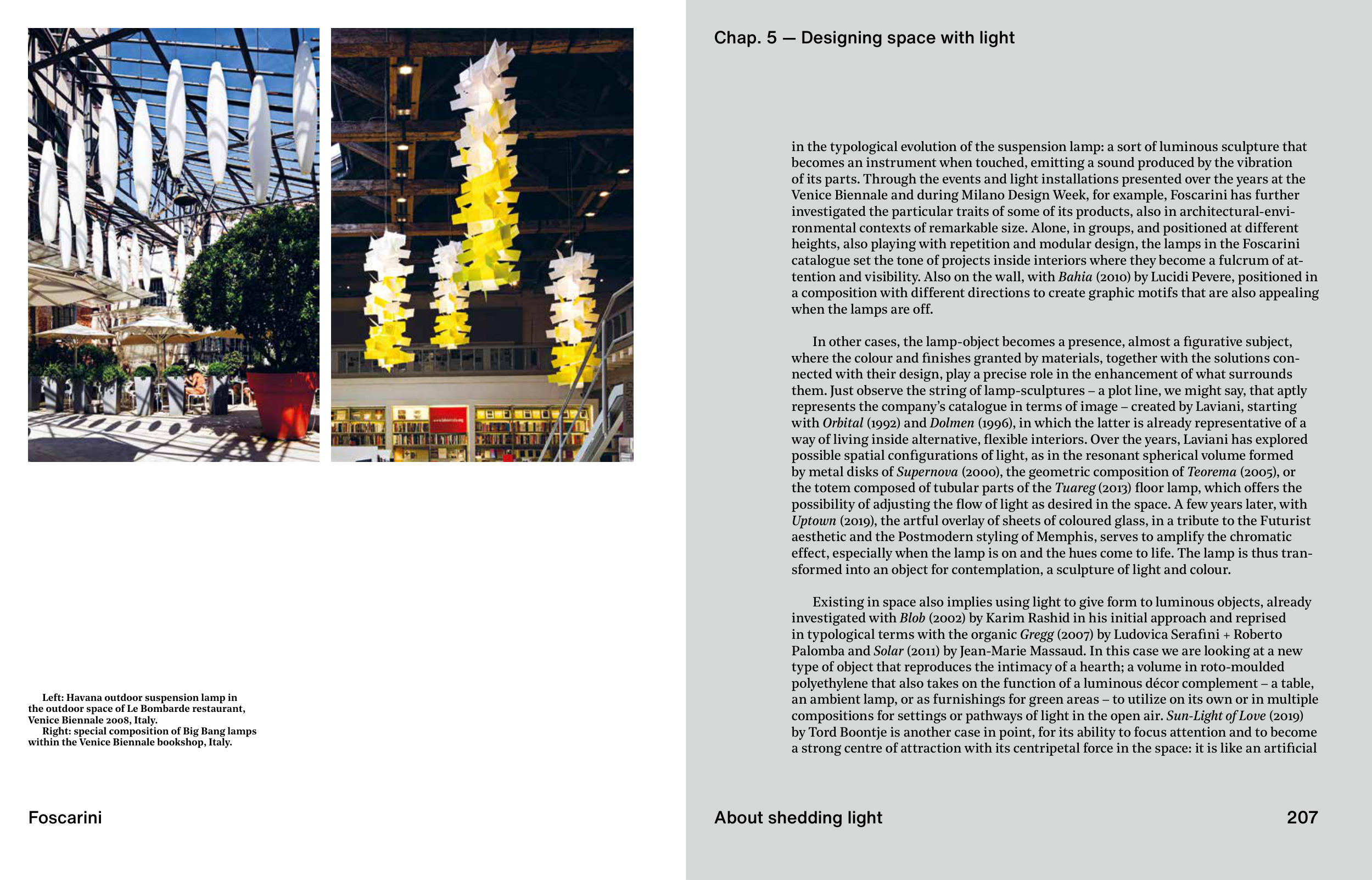Foscarini
207
Left: Havana outdoor suspension lamp in
the outdoor space of Le Bombarde restaurant,
Venice Biennale 2008, Italy.
Right: special composition of Big Bang lamps
within the Venice Biennale bookshop, Italy.
About shedding light
Chap. 5 — Designing space with light
in the typological evolution of the suspension lamp: a sort of luminous sculpture that
becomes an instrument when touched, emitting a sound produced by the vibration
of its parts. Through the events and light installations presented over the years at the
Venice Biennale and during Milano Design Week, for example, Foscarini has further
investigated the particular traits of some of its products, also in architectural-envi-
ronmental contexts of remarkable size. Alone, in groups, and positioned at different
heights, also playing with repetition and modular design, the lamps in the Foscarini
catalogue set the tone of projects inside interiors where they become a fulcrum of at-
tention and visibility. Also on the wall, with Bahia (2010) by Lucidi Pevere, positioned in
a composition with different directions to create graphic motifs that are also appealing
when the lamps are off.
In other cases, the lamp-object becomes a presence, almost a fi gurative subject,
where the colour and fi nishes granted by materials, together with the solutions con-
nected with their design, play a precise role in the enhancement of what surrounds
them. Just observe the string of lamp-sculptures – a plot line, we might say, that aptly
represents the company’s catalogue in terms of image – created by Laviani, starting
with Orbital (1992) and Dolmen (1996), in which the latter is already representative of a
way of living inside alternative, fl exible interiors. Over the years, Laviani has explored
possible spatial confi gurations of light, as in the resonant spherical volume formed
by metal disks of Supernova (2000), the geometric composition of Teorema (2005), or
the totem composed of tubular parts of the Tuareg (2013) fl oor lamp, which offers the
possibility of adjusting the fl ow of light as desired in the space. A few years later, with
Uptown (2019), the artful overlay of sheets of coloured glass, in a tribute to the Futurist
aesthetic and the Postmodern styling of Memphis, serves to amplify the chromatic
effect, especially when the lamp is on and the hues come to life. The lamp is thus tran-
sformed into an object for contemplation, a sculpture of light and colour.
Existing in space also implies using light to give form to luminous objects, already
investigated with Blob (2002) by Karim Rashid in his initial approach and reprised
in typological terms with the organic Gregg (2007) by Ludovica Serafi ni + Roberto
Palomba and Solar (2011) by Jean-Marie Massaud. In this case we are looking at a new
type of object that reproduces the intimacy of a hearth; a volume in roto-moulded
polyethylene that also takes on the function of a luminous décor complement – a table,
an ambient lamp, or as furnishings for green areas – to utilize on its own or in multiple
compositions for settings or pathways of light in the open air. Sun-Light of Love (2019)
by Tord Boontje is another case in point, for its ability to focus attention and to become
a strong centre of attraction with its centripetal force in the space: it is like an artifi cial
207


